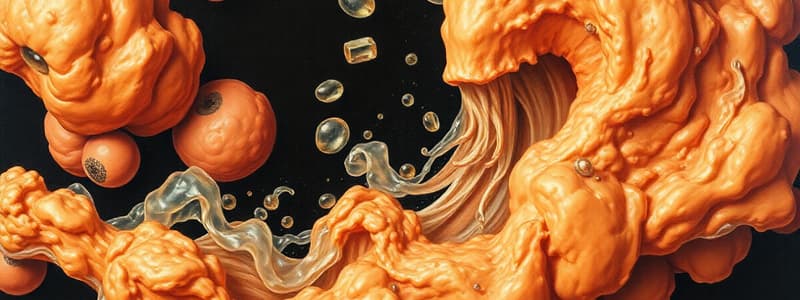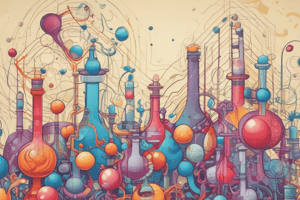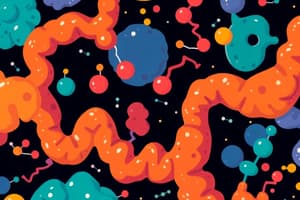Podcast
Questions and Answers
What is the term used for a chain of 3 to 10 amino acids?
What is the term used for a chain of 3 to 10 amino acids?
- Oligopeptides (correct)
- Polypeptides
- Tripeptides
- Dipeptide
Which type of proteins have two or more polypeptides associated noncovalently?
Which type of proteins have two or more polypeptides associated noncovalently?
- Simple proteins
- Multisubunit proteins (correct)
- Conjugated proteins
- Monomeric proteins
What is an essential function of the prosthetic group in a protein?
What is an essential function of the prosthetic group in a protein?
- To contribute to the protein's biological function (correct)
- To enhance protein solubility
- To form peptide bonds between amino acids
- To stabilize the amino acid sequence
Which of the following classifications includes proteins comprising permanently associated chemical components?
Which of the following classifications includes proteins comprising permanently associated chemical components?
How is an amino acid sequence typically displayed in a peptide or protein?
How is an amino acid sequence typically displayed in a peptide or protein?
What is the significance of the unique structure of macromolecules?
What is the significance of the unique structure of macromolecules?
Which type of bond is formed between amino acids in proteins?
Which type of bond is formed between amino acids in proteins?
How many standard amino acids are commonly found in proteins?
How many standard amino acids are commonly found in proteins?
What role do noncovalent interactions play in macromolecules?
What role do noncovalent interactions play in macromolecules?
What is the function of water in relation to biomolecules?
What is the function of water in relation to biomolecules?
What is the α carbon in amino acids?
What is the α carbon in amino acids?
What determines the distinct chemical and functional properties of individual proteins?
What determines the distinct chemical and functional properties of individual proteins?
What additional amino acids are incorporated by special translation mechanisms?
What additional amino acids are incorporated by special translation mechanisms?
How do the R groups of amino acids influence their properties?
How do the R groups of amino acids influence their properties?
What is a characteristic of a chiral center in an amino acid?
What is a characteristic of a chiral center in an amino acid?
Which amino acid class is characterized by nonpolar and hydrophobic side chains?
Which amino acid class is characterized by nonpolar and hydrophobic side chains?
Which of the following amino acids has a net negative charge at pH 7.0?
Which of the following amino acids has a net negative charge at pH 7.0?
How do hydroxyl groups in polar uncharged R groups affect amino acids?
How do hydroxyl groups in polar uncharged R groups affect amino acids?
What distinguishes cysteine amongst polar uncharged R group amino acids?
What distinguishes cysteine amongst polar uncharged R group amino acids?
Which amino acid is considered an intermediate in the urea cycle?
Which amino acid is considered an intermediate in the urea cycle?
What happens during the condensation polymerization of amino acids?
What happens during the condensation polymerization of amino acids?
Which protein class is characterized by being soluble in 70 to 80% ethanol but insoluble in water?
Which protein class is characterized by being soluble in 70 to 80% ethanol but insoluble in water?
What role do amino acids with charged R groups play at pH 7.0?
What role do amino acids with charged R groups play at pH 7.0?
What are enantiomers?
What are enantiomers?
What stabilizes the alpha-helix structure of proteins?
What stabilizes the alpha-helix structure of proteins?
Which protein type is primarily associated with structural functions in the body?
Which protein type is primarily associated with structural functions in the body?
Which amino acid acts as a precursor to dopamine?
Which amino acid acts as a precursor to dopamine?
What property distinguishes the aromatic amino acids phenylalanine, tyrosine, and tryptophan?
What property distinguishes the aromatic amino acids phenylalanine, tyrosine, and tryptophan?
What is the primary structure of a protein determined by?
What is the primary structure of a protein determined by?
Which type of derived protein is formed as an intermediate during protein hydrolysis?
Which type of derived protein is formed as an intermediate during protein hydrolysis?
Which amino acids can be categorized as having negatively charged R groups at pH 7?
Which amino acids can be categorized as having negatively charged R groups at pH 7?
Which class of amino acids tends to cluster together due to the hydrophobic effect in proteins?
Which class of amino acids tends to cluster together due to the hydrophobic effect in proteins?
What is the configuration that proline residues can form in peptide bonds?
What is the configuration that proline residues can form in peptide bonds?
Which of the following compounds is not a type of compound protein?
Which of the following compounds is not a type of compound protein?
What forces are responsible for stabilizing protein structures?
What forces are responsible for stabilizing protein structures?
Which protein structure is defined as the three-dimensional fold adopted by a protein?
Which protein structure is defined as the three-dimensional fold adopted by a protein?
Which of the following is not a class of proteins based on their function?
Which of the following is not a class of proteins based on their function?
Which type of protein is characterized by polypeptide chains arranged in long strands or sheets?
Which type of protein is characterized by polypeptide chains arranged in long strands or sheets?
What is the primary structural characteristic of β-sheets?
What is the primary structural characteristic of β-sheets?
What defines the tertiary structure of a protein?
What defines the tertiary structure of a protein?
Which of the following statements is true regarding globular proteins?
Which of the following statements is true regarding globular proteins?
The spontaneous folded state of globular proteins is influenced by which of the following interactions?
The spontaneous folded state of globular proteins is influenced by which of the following interactions?
In β-sheets, the orientation of R groups in adjacent residues is described as:
In β-sheets, the orientation of R groups in adjacent residues is described as:
What is a domain in the context of protein structure?
What is a domain in the context of protein structure?
Which of these best describes fibrous proteins?
Which of these best describes fibrous proteins?
What is the term for the irreversible loss of protein structure that leads to a loss of function?
What is the term for the irreversible loss of protein structure that leads to a loss of function?
Which of the following best describes oligomeric proteins?
Which of the following best describes oligomeric proteins?
Which process may lead to denaturation of proteins?
Which process may lead to denaturation of proteins?
How many essential amino acids must be obtained from the diet for adults?
How many essential amino acids must be obtained from the diet for adults?
What is the recommended dietary allowance (RDA) of protein for a healthy adult in grams per kilogram of body weight per day?
What is the recommended dietary allowance (RDA) of protein for a healthy adult in grams per kilogram of body weight per day?
Which type of amino acids can the body synthesize, thus considered nonessential?
Which type of amino acids can the body synthesize, thus considered nonessential?
What is the Acceptable Macronutrient Distribution Range (AMDR) for protein for adults as a percentage of total kilocalories?
What is the Acceptable Macronutrient Distribution Range (AMDR) for protein for adults as a percentage of total kilocalories?
Which of the following is a conditionally essential amino acid, potentially required during specific life stages or conditions?
Which of the following is a conditionally essential amino acid, potentially required during specific life stages or conditions?
Flashcards
Polymeric Macromolecules
Polymeric Macromolecules
Large molecules consisting of repeating units called monomers, found in living organisms. They are highly ordered with specific sequences of monomers determining their structure and function.
Proteins
Proteins
A group of biomolecules crucial for life, often acting as catalysts (enzymes) or structural components. They are linear chains of amino acids linked by peptide bonds.
Amino Acids
Amino Acids
Building blocks of proteins, small organic molecules with an amino group, a carboxyl group, and a side chain specific to each amino acid.
Peptide Bond
Peptide Bond
Signup and view all the flashcards
Amino Acid Sequence
Amino Acid Sequence
Signup and view all the flashcards
Protein Structure
Protein Structure
Signup and view all the flashcards
Protein Denaturation
Protein Denaturation
Signup and view all the flashcards
Noncovalent Interactions in Proteins
Noncovalent Interactions in Proteins
Signup and view all the flashcards
Dipeptide
Dipeptide
Signup and view all the flashcards
Oligopeptide
Oligopeptide
Signup and view all the flashcards
Polypeptide
Polypeptide
Signup and view all the flashcards
Multisubunit Proteins
Multisubunit Proteins
Signup and view all the flashcards
Conjugated Proteins
Conjugated Proteins
Signup and view all the flashcards
Tertiary structure
Tertiary structure
Signup and view all the flashcards
Domain
Domain
Signup and view all the flashcards
Interactions that govern tertiary structure
Interactions that govern tertiary structure
Signup and view all the flashcards
Fibrous Proteins
Fibrous Proteins
Signup and view all the flashcards
Globular Proteins
Globular Proteins
Signup and view all the flashcards
Beta Sheets
Beta Sheets
Signup and view all the flashcards
Alpha Helix
Alpha Helix
Signup and view all the flashcards
Quaternary Structure
Quaternary Structure
Signup and view all the flashcards
Secondary Derived Protein
Secondary Derived Protein
Signup and view all the flashcards
Catalytic protein (enzyme)
Catalytic protein (enzyme)
Signup and view all the flashcards
Primary Protein Structure
Primary Protein Structure
Signup and view all the flashcards
Transport Protein
Transport Protein
Signup and view all the flashcards
Structural Protein
Structural Protein
Signup and view all the flashcards
Tertiary Protein Structure
Tertiary Protein Structure
Signup and view all the flashcards
Immune Protein (gamma-globulin)
Immune Protein (gamma-globulin)
Signup and view all the flashcards
Contractile Protein
Contractile Protein
Signup and view all the flashcards
Simple Protein
Simple Protein
Signup and view all the flashcards
R group
R group
Signup and view all the flashcards
Polarity of R groups
Polarity of R groups
Signup and view all the flashcards
Chiral center
Chiral center
Signup and view all the flashcards
Enantiomers
Enantiomers
Signup and view all the flashcards
Amino acid classification
Amino acid classification
Signup and view all the flashcards
Hydrophobic effect
Hydrophobic effect
Signup and view all the flashcards
Nonpolar, aliphatic R groups
Nonpolar, aliphatic R groups
Signup and view all the flashcards
Glycine
Glycine
Signup and view all the flashcards
Aromatic R groups
Aromatic R groups
Signup and view all the flashcards
Polar, uncharged R groups
Polar, uncharged R groups
Signup and view all the flashcards
Cysteine
Cysteine
Signup and view all the flashcards
Positively charged (basic) R groups
Positively charged (basic) R groups
Signup and view all the flashcards
Negatively charged (acidic) R groups
Negatively charged (acidic) R groups
Signup and view all the flashcards
Non-standard amino acids
Non-standard amino acids
Signup and view all the flashcards
Amino acids as acids or bases
Amino acids as acids or bases
Signup and view all the flashcards
Polymerisation of amino acids
Polymerisation of amino acids
Signup and view all the flashcards
Myglobin
Myglobin
Signup and view all the flashcards
Dimeric Protein
Dimeric Protein
Signup and view all the flashcards
Oligomeric Proteins
Oligomeric Proteins
Signup and view all the flashcards
Essential Amino Acids
Essential Amino Acids
Signup and view all the flashcards
Protein Intake
Protein Intake
Signup and view all the flashcards
Protein Sources
Protein Sources
Signup and view all the flashcards
Study Notes
Biomolecules
- Biomolecules include proteins, carbohydrates, lipids, and nucleic acids.
Amino Acids, Peptides, and Proteins
- Proteins are constructed from a common set of 20 amino acids (AAs) in all living organisms.
- 20 standard proteinogenic AAs are encoded by the standard genetic code.
- Additional 2 AAs (selenocysteine and pyrrolysine) are incorporated using special translation mechanisms.
- AAs are joined in characteristic linear sequences by peptide bonds, a carbonyl carbon-to-nitrogen bond.
- Proteins' chemical and functional properties are determined by their unique AA sequence.
Three Interrelated Principles
- The unique structure of each macromolecule determines its function.
- Noncovalent interactions play a critical role in the structure and function of macromolecules.
- Monomeric subunits in polymeric macromolecules occur in specific sequences, representing information vital for the ordered living state.
Water's Influence on Biomolecules
- Water's ionization products (H+ and OH-) profoundly influence the structure, self-assembly, and properties of cellular components (proteins, nucleic acids, and lipids).
- Noncovalent interactions among biomolecules are significantly influenced by water's properties as a solvent, including its ability to form hydrogen bonds with itself and solutes.
Amino Acids
- Amino acids have an amino group and a carboxylic acid group attached to the same alpha carbon.
- Side chains (R groups) distinguish different amino acids. The R groups vary in structure, size, and charge, which affects solubility in water.
- The alpha carbon atom is a chiral center due to the tetrahedral arrangement of bonding orbitals.
- Amino acids exist as two enantiomers (mirror images), each with a distinct configuration designated as L or D.
Classification of Amino Acids by R Groups
- Amino acids are broadly classified into five groups based on the properties of their R groups, considering their polarity and tendency to interact with water at biological pH.
- The R groups vary widely in polarity, ranging from nonpolar and hydrophobic to highly polar and hydrophilic.
- Some amino acids do not precisely fit into one specific category, including glycine, histidine, and cysteine.
Nonpolar, Aliphatic R Groups
- Nonpolar, aliphatic R groups are characterized by hydrophobic side chains.
- Alanine, valine, leucine, and isoleucine tend to cluster in proteins, contributing to the protein's structure through the hydrophobic effect.
- Glycine has the simplest structure.
- Methionine is one of the two sulfur-containing amino acids.
- Proline features a distinctive cyclic structure.
Aromatic R Groups
- Phenylalanine, tyrosine, and tryptophan have aromatic side chains and are relatively nonpolar (hydrophobic).
- These AAs also contribute to the hydrophobic effect within proteins.
- The hydroxyl group of tyrosine participates in hydrogen bonding and plays a significant role in some enzymes.
Polar, Uncharged R Groups
- Polar, uncharged R groups are more soluble in water (hydrophilic) due to functional groups forming hydrogen bonds with water.
- Include serine, threonine, cysteine, asparagine, and glutamine.
- Cysteine is notable for its -SH group, which can form disulfide bonds.
- Asparagine and glutamine contain amide groups.
Positively Charged (Basic) R Groups
- Positively charged amino acids have R groups that carry a positive charge at a neutral pH.
- Lysine, arginine, and histidine are examples and are the most hydrophilic.
- Histidine has an aromatic imidazole group, which can participate in proton transfer reactions.
Negatively Charged (Acidic) R Groups
- Aspartate and glutamate have R groups with a net negative charge at a neutral pH.
- These R groups contain a second carboxyl group.
Non-Standard Amino Acids
- Some amino acids are not used in protein synthesis but play essential roles in the body.
- Modification of common amino acids (e.g., 4-hydroxyproline) and free metabolites (e.g., citrulline, ornithine, taurine) may occur.
- Specific examples, like L-DOPA, GABA, and others, play crucial roles in the body.
Essential vs. Nonessential Amino Acids
- Amino acids are classified as essential or nonessential based on the body's ability to synthesize them.
- Essential amino acids must be obtained from the diet.
- Nonessential amino acids can be synthesized by the body.
- Some nonessential amino acids may become essential under specific conditions, known as conditionally essential.
AA Derivatives
- Some amino acids can be converted into various derivative molecules with important functions.
- Examples of important derivatives include Dopamine (tyrosine), Norepinephrine, and Epinephrine (phenylalanine, tyrosine); Histamine (histidine), and GABA (glutamate).
Protein Intake
- Recommended dietary allowance (RDA) for protein intake is determined by nitrogen balance. It varies based on factors like age and activity level.
Protein Structure
- Proteins' diverse functions originate from their complex structures.
- Amino acids join to form the primary structure; this sequence is the blueprint.
- Secondary structure features regular patterns like alpha-helices and beta-sheets, held together by hydrogen bonds.
- Tertiary structure is the overall three-dimensional shape, crucial for function, stabilized by various non-covalent interactions.
- Quaternary structure describes multiple polypeptide chains interacting noncovalently, forming complex structures.
Loss of Protein Function (Denaturation)
- Denaturation is a loss of protein three-dimensional structure.
- Denaturation can occur due to factors like temperature changes, pH extremes, heavy metal salts, and other agents disrupting structural interactions.
- Denaturation is often irreversible, leading to loss of function, except in certain cases.
Classification of Proteins
- Classification can be based on chemical properties, such as simple (contain only amino acids), compound proteins ( contain elements/residues besides amino acids), , and derived proteins ( modified form of simple/compound proteins)
- Alternatively, classification can be done based on function or properties, such as catalytic, structural, storage , transport, genetic and more.
Studying That Suits You
Use AI to generate personalized quizzes and flashcards to suit your learning preferences.




